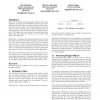Free Online Productivity Tools
i2Speak
i2Symbol
i2OCR
iTex2Img
iWeb2Print
iWeb2Shot
i2Type
iPdf2Split
iPdf2Merge
i2Bopomofo
i2Arabic
i2Style
i2Image
i2PDF
iLatex2Rtf
Sci2ools
IWMM
2000
Springer
2000
Springer
On the Effectiveness of GC in Java
We study the effectiveness of garbage collection (GC) algorithms by measuring the time difference between the actual collection time of an object and the potential earliest collection time for that object. Our ultimate goal is to use this study in order to develop static analysis techniques that can be used together with GC to allow earlier reclamation of objects. The results may also be used to pinpoint application source code that could be rewritten in a way that would allow more timely GC. Specifically, we compare the objects reachable from the root set to the ones that are actually used again. The idea is that GC could reclaim unused objects even if they are reachable from the root set. Thus, our experiments indicate a kind of upper bound on storage savings that could be achieved. We also try to characterize these objects in order to understand the potential benefits of various static analysis algorithms. The Java Virtual Machine (JVM) was instrumented to measure objects that are ...
| Added | 25 Aug 2010 |
| Updated | 25 Aug 2010 |
| Type | Conference |
| Year | 2000 |
| Where | IWMM |
| Authors | Ran Shaham, Elliot K. Kolodner, Shmuel Sagiv |
Comments (0)

